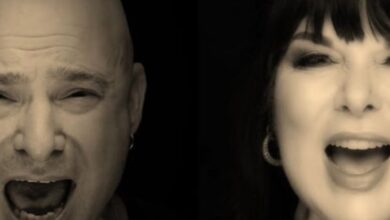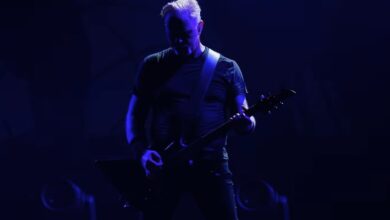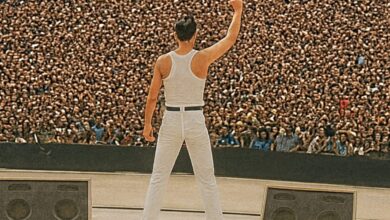Disturbed’s Unforgettable Conan Rendition Elevates “The Sound of Silence” Into a Haunting, Generation-Defining Masterpiece
When March 2016 arrived, nobody anticipated that one of metal’s loudest and most unrelenting bands would strip away its ferocity to embrace quiet vulnerability. On March 28, 2016, Disturbed took to the stage on Late Night with Conan O’Brien, delivering a performance that shattered all expectations. Their chilling interpretation of Simon & Garfunkel’s “The Sound of Silence” silenced the studio in awe. It wasn’t merely a cover—it was a metamorphosis, where raw emotion replaced volume, and the result forever altered their artistic identity.
Fans in the studio expected an eruption of guitars and thunderous drums, the signature chaos of Disturbed’s sound. Instead, they were greeted by an atmosphere thick with quiet intensity. The lights dimmed until only shadows framed the musicians. Then David Draiman’s baritone broke the silence, controlled yet fragile, reciting the opening lines with reverence. Each word seemed to vibrate in the still air, holding the audience in hypnotic suspension as the music built a cathedral of sound out of near silence.
That evening blurred the barrier between generations. Among the millions who later watched the broadcast was Paul Simon, the song’s original writer. Deeply moved by what he heard, Simon personally emailed Draiman on April 1, 2016, to express admiration for their reimagining. He described the rendition as “deeply moving and powerfully emotional,” recognizing that the band had carried his creation into a new era. It was a rare artistic handshake between past and present, bridging decades of musical evolution.
Draiman responded with heartfelt gratitude, calling Simon’s praise one of the greatest honors of his life. He made it clear that Disturbed’s intent had never been competition—it was homage. The band sought to amplify the song’s timeless reflection on alienation and yearning, not overshadow it. This exchange of respect transformed the cover into a dialogue across time. One artist wrote the melody; another gave it modern pulse—both united by a shared language of emotional truth.
The song had first appeared on Disturbed’s 2015 album Immortalized, an unexpected gem among the record’s storm of heavy anthems. Its soft power made it an instant standout, earning unexpected radio traction. Within months, it climbed to number 42 on the Billboard Hot 100 and dominated rock charts across the world. Listeners were stunned—a metal band best known for aggression had created its most devastatingly beautiful moment through restraint and silence.
Released as a single in December 2015, the studio version unveiled the full scope of the band’s transformation. Guitarist Dan Donegan replaced distortion with intricate acoustic layering, weaving piano and EBow tones that shimmered like echoes in a sacred hall. Drummer Mike Wengren shifted from explosive rhythms to orchestral heartbeat, letting timpani and cymbals breathe between Draiman’s soaring voice. What emerged was cinematic and spiritual—an anthem not of power, but of profound grace.
When that arrangement was brought to Conan’s stage, something transcendent took place. The talk show, usually alive with chatter, turned into a chapel of silence. Draiman’s voice trembled with emotion yet commanded the room as he reached the song’s climactic cry. By the final note, the audience sat frozen, caught between tears and disbelief. Viewers at home described chills that refused to fade, realizing they had witnessed not a performance, but a revelation—a metal band mastering the art of quiet intensity.
As expected from any daring reinvention, opinions varied. Some dismissed it as melodramatic, others hailed it as brilliance. But even the skeptics conceded the undeniable sincerity pulsing through every note. The band’s vulnerability stood in stark contrast to the cynicism of modern music. What they achieved that night wasn’t spectacle—it was connection. In an era numbed by irony, their fearless sincerity felt revolutionary, reminding audiences that honesty still cuts deepest.
The ripple effect was immediate. By 2017, sales exceeded 1.5 million digital copies, and the song amassed hundreds of millions of streams worldwide. The official video passed the billion-view mark, while the Conan performance alone surpassed 150 million views—an unmatched feat for a late-night show. Disturbed had proven that emotional truth transcends genre. Metalheads, pop listeners, and folk enthusiasts all met on common ground, drawn together by the haunting beauty of a single melody.
The magic of the moment came from contrast. Fury transformed into grace; heaviness into space; rebellion into reflection. Disturbed did not parody “The Sound of Silence”—they sanctified it. Their version was neither nostalgic nor ironic but reverent, channeling a primal respect that made the song’s despair luminous. Watching them was like standing inside a storm’s still eye, where chaos pauses just long enough for humanity to be heard.
For the band, that performance signified more than a return—it was a rebirth. After a lengthy hiatus, Immortalized had already put them back on the charts at number one, but “The Sound of Silence” gave them purpose. It redefined what Disturbed could be: introspective yet powerful, vulnerable yet unbreakable. The moment crystallized the truth that emotional depth and metal intensity could coexist without contradiction.
The shift in tone owed much to producer Kevin Churko, who helped the band balance grandeur with intimacy. He guided them toward restraint, using strings, piano, and silence as instruments of tension. Instead of rage, they embraced stillness; instead of walls of sound, they built cathedrals of emotion. The arrangement blurred the boundary between symphony and rock, demonstrating that sometimes the boldest act of strength is the choice to be delicate.
Recognition soon followed. In 2017, the performance earned a Grammy nomination for Best Rock Performance, affirming the band’s creative courage. For Disturbed, awards were secondary—the real victory was artistic validation. Their willingness to take risks proved that authenticity still resonates louder than trend. The song became a beacon for musicians seeking depth over formula, showing that vulnerability could indeed be the new form of power.
Those lucky enough to attend the live taping often recount the memory with reverence. Expecting their eardrums to shatter, they instead found their hearts trembling. The revelation was almost spiritual: true volume doesn’t come from noise—it comes from emotion. When the final chord faded, applause broke not in chaos but in quiet awe. In that moment, the audience recognized they had witnessed something sacred disguised as entertainment.
The performance altered not just Disturbed’s path but the wider perception of modern rock itself. Couples held each other, strangers wept, and fans rediscovered the soul beneath the distortion. It wasn’t nostalgia; it was rebirth. A song born from 1960s unrest had found resurrection in the digital age, carrying the same truth through a new voice—one unafraid to let silence roar.
Years later, their version of “The Sound of Silence” endures as more than a cover—it stands as a definitive modern classic. It honors its origins while transcending them, reminding listeners that reinvention can preserve, not destroy, what came before. Draiman didn’t merely perform the song; he revived its spirit. Through his voice and the band’s restraint, silence itself became the loudest, most unforgettable sound of all.
In 2019, Disturbed teamed up with Myles Kennedy for a rare live duet of The Sound of Silence, and the result was a masterclass in vocal chemistry. Kennedy’s soaring, crystal-clear tone wrapped around David Draiman’s darker, resonant voice in a way that made the song even more cinematic and tragic. The audience wasn’t just listening — they were watching two completely different styles of singers meet in the middle and lift the song to a new emotional height.
The original studio version, released on the Immortalized album, still remains the definitive modern take for many listeners. Its slow build, haunting strings, carefully layered guitars, and Draiman’s controlled delivery created a version that felt reverent to Simon & Garfunkel while sounding unmistakably like Disturbed. That recording is the reason millions discovered the song again, and it continues to pull in streams and views years later because of how clean, pure, and emotionally focused it is.





